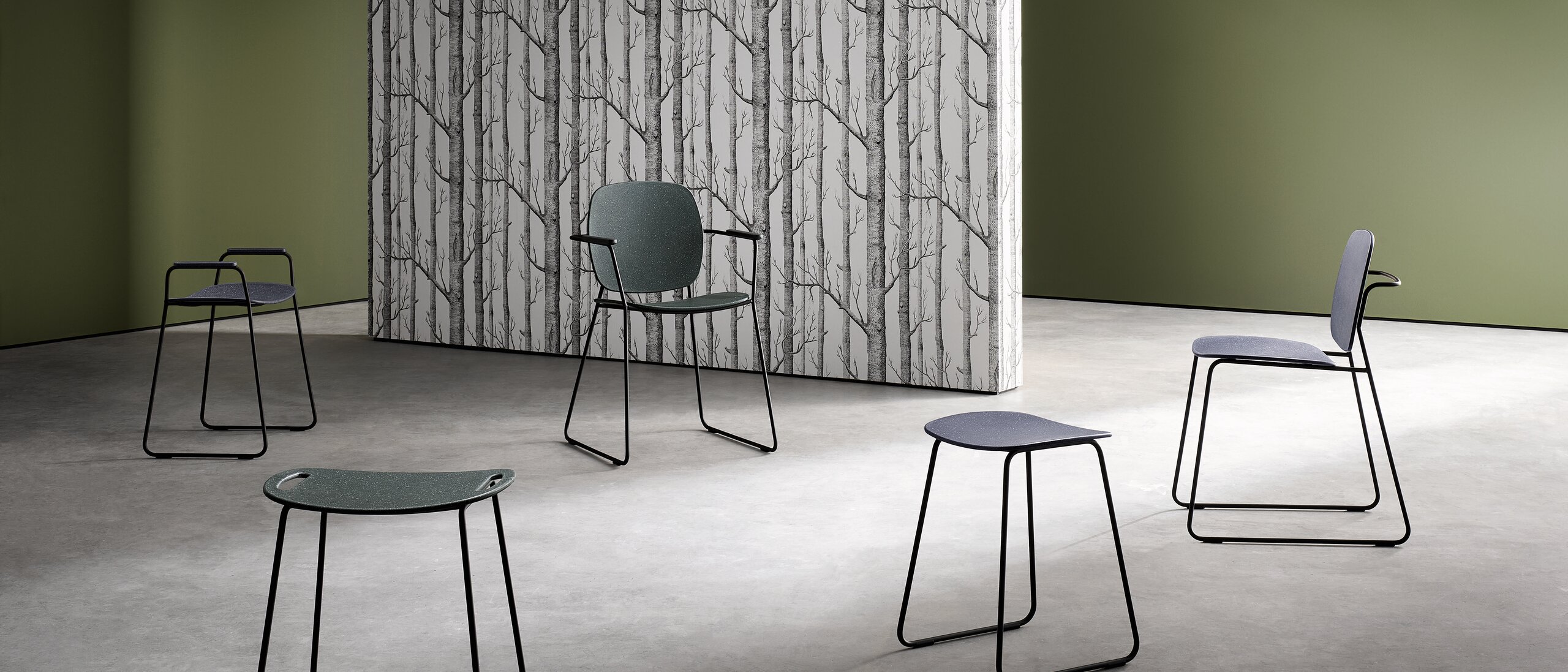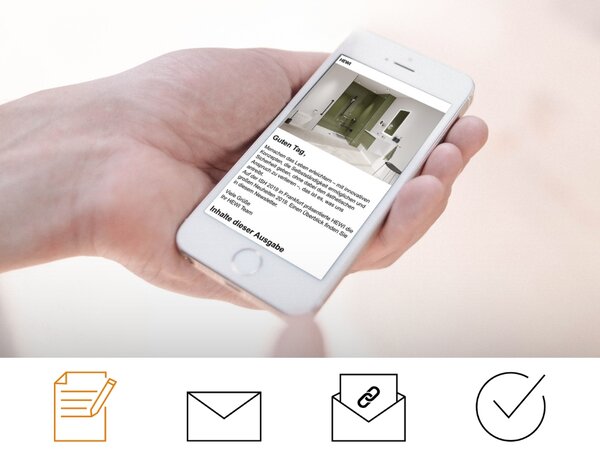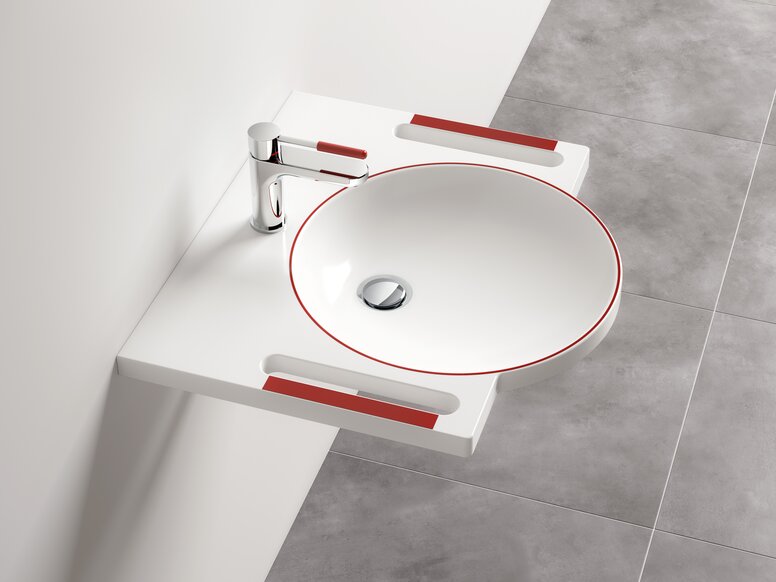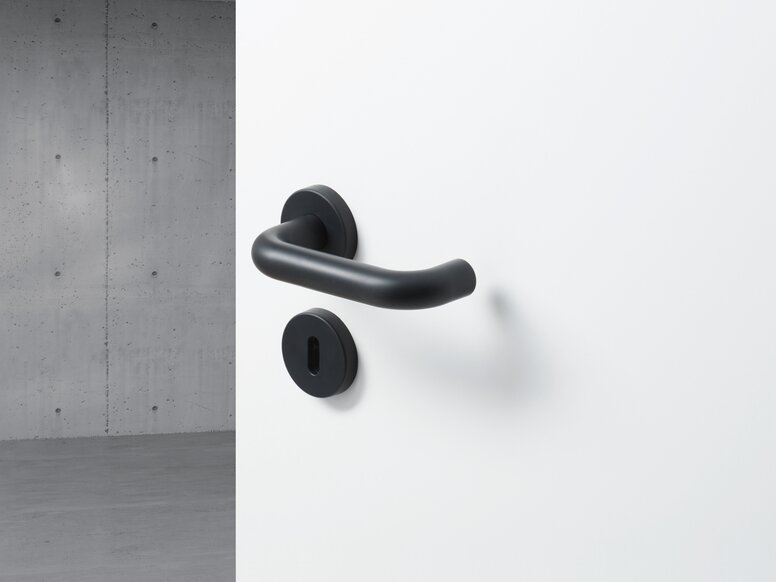HEWI MAG / Sanitary
Sustainability in the bathroom: how to design your customers' bathrooms sustainably
Sustainability is on everyone's lips. Whether in everyday life, in society or in architecture: we encounter sustainable measures everywhere. We want to take “Day of the Bath” on 16 September 2023 as an opportunity to take a closer look at this topic. In this article, we will show you how to bring both environmental and social sustainability into your customers' bathrooms with the help of valuable tips.
The issue of sustainability concerns everyone. Climate change is now having all sorts of impact on nature, society and the economy. Glaciers are thawing, there are more and more hot days in summer, the behaviour of migratory birds is changing – and spring also starts much earlier than 40 years ago.1 In order to protect the climate and make society inclusive, sustainable measures are obligatory – also in the bathroom design environment. Topics such as making everyday life sustainable, planning new buildings and renovations with foresight and using suitable materials in construction are crucial to counteracting climate change. The following tips help to implement sustainability in bathroom planning.
1. Rely on sustainable materials and environmentally conscious product manufacturing
When designing a bathroom sustainably, it is essential to consider the choice of materials. When it comes to building materials, more attention is being paid to the environmental friendliness of the materials used, for the benefit of the climate. Wood, straw and hemp are considered to be particularly climate-friendly building materials, as they are renewable and have a positive ecological balance. In addition to the choice of materials, the manufacturing process is also very important in terms of sustainability. Products that are CO2-neutral, regionally produced and have a short supply chain are recommended in this respect, for example.
Further information on the Re seating family can be found in the interview with Senior Product Manager Susan Herrmann.
The stools and chairs of the sustainable Re-seat family from HEWI, for example, are made of post-industrial recyclate and are a statement for superlative ecological design. In the natural colours forest green and dark granite grey, the Re-seat family impresses both to the touch and visually with its extraordinary design. Its special feature: HEWI manufactures the Re-seat family from recycled polypropylene and recycled polyamide. The latter comes from the company's own production, while the former is sourced from a regionally based supplier, which in turn benefits the supply chain. However, this sustainable approach does not mean that design is neglected. Quite the opposite: each stool is unique because the materials used have a different melting point, which results in a mottled structure in the surface during the injection moulding process.
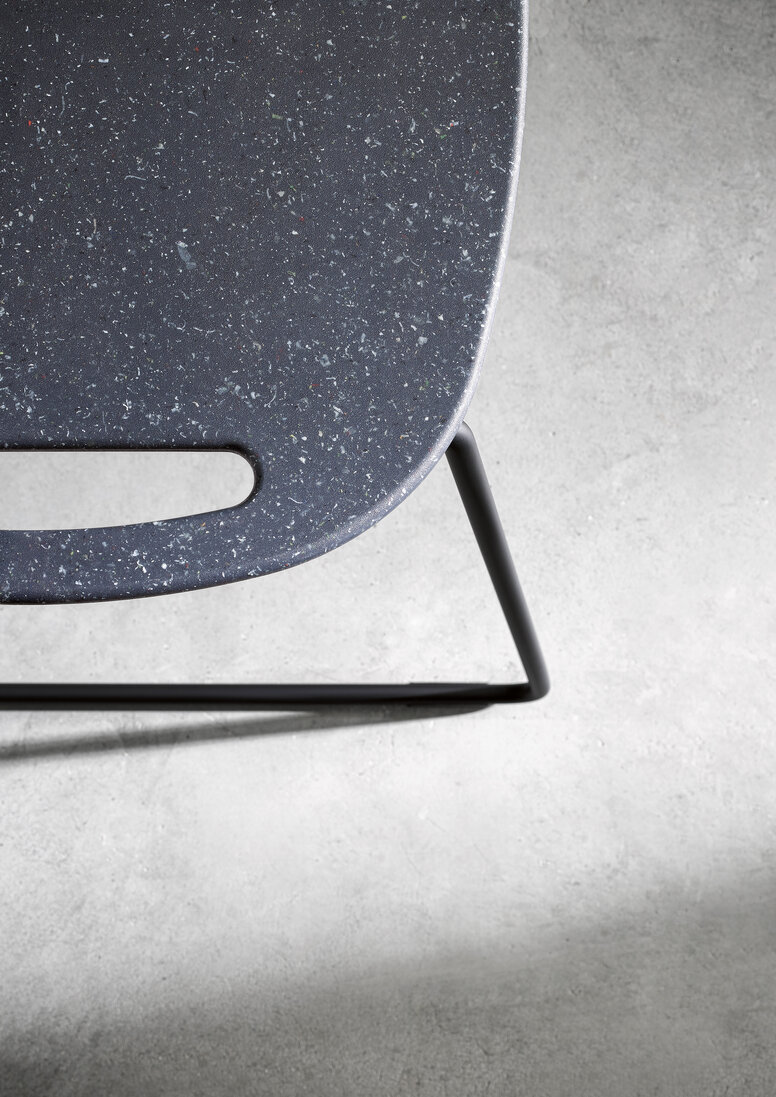

2. Plan the bathroom with foresight
The foresighted and thoughtful planning of a bathroom influences its sustainability. Thus, smaller bathrooms require fewer resources such as building materials, furniture or energy. It is also important to pay attention to product selection. When it comes to sustainable bathrooms, opt for robust and durable products. High-quality processed materials are more durable and last a long time even with heavy use in everyday life. As a result, it is usually not necessary to replace sanitary products until many years later. Durable solutions counteract the short service life of products and save valuable resources.
A well-designed bathroom also promotes social sustainability. Thus, older people or people with physical disabilities are integrated into everyday life when you plan and equip a bathroom for all generations. Especially in times of demographic change, this is of great importance for an inclusive society.
With the barrier-free sanitary range HEWI offers you and your customers durable, robust products that focus on the needs of everyone and provide the best possible support for users in self-determined everyday life.
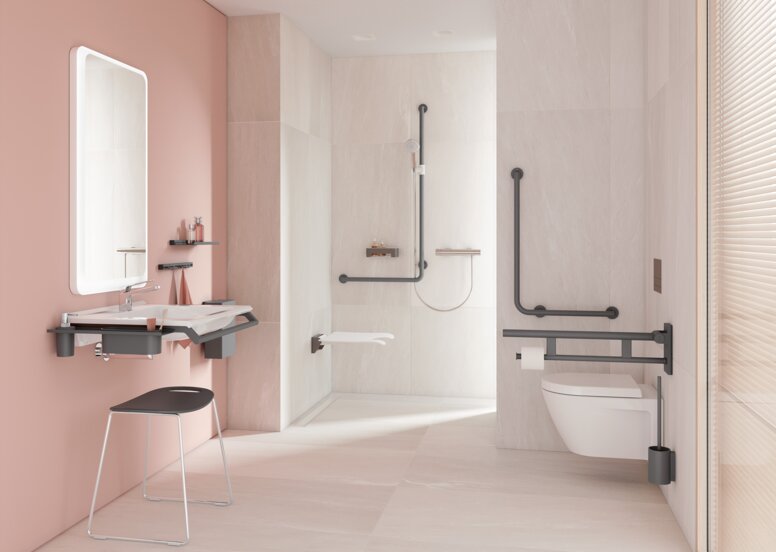
3. Choose easy-care products
You may wonder about the impact that caring for a product may have on the climate and sustainability. After all, at first glance, care seems secondary, but this aspect should not be underestimated. By making bathroom cleaning as uncomplicated as possible, cleaning agents, energy and water can be actively saved. For example, rimless WCs or washbasins without an overflow are easier and quicker to clean. In addition, joints in products tend to be a hindrance in cleaning.
HEWI mineral cast washbasins have a high-gloss pore-free surface that is particularly hygienic and easy to clean. Thanks to their functional design, they are very versatile. The barrier-free washbasin models make everyday life easier for physically impaired people and promote their independence – social and ecological sustainability in the bathroom are combined here.
4. Rely on resource-saving products
Saving resources is an important contribution to protecting the climate. Water is one of the most vital resources and must be treated with particular care. In order not to waste water in the bathroom and to counteract a non-stop flow of water, resource-saving products are a good choice in the bathroom.
Electronic fittings are particularly water-saving, easy to clean and robust – as a result, they contribute to a sustainable bathroom on several levels. The intelligent sensor technology of the fittings noticeably reduces water consumption. The taps are triggered by a sensor and stop the water flow automatically after a preset time interval. Thanks to their robust design, these fittings are particularly durable. They are often used in public areas – a place where saving water is particularly important.
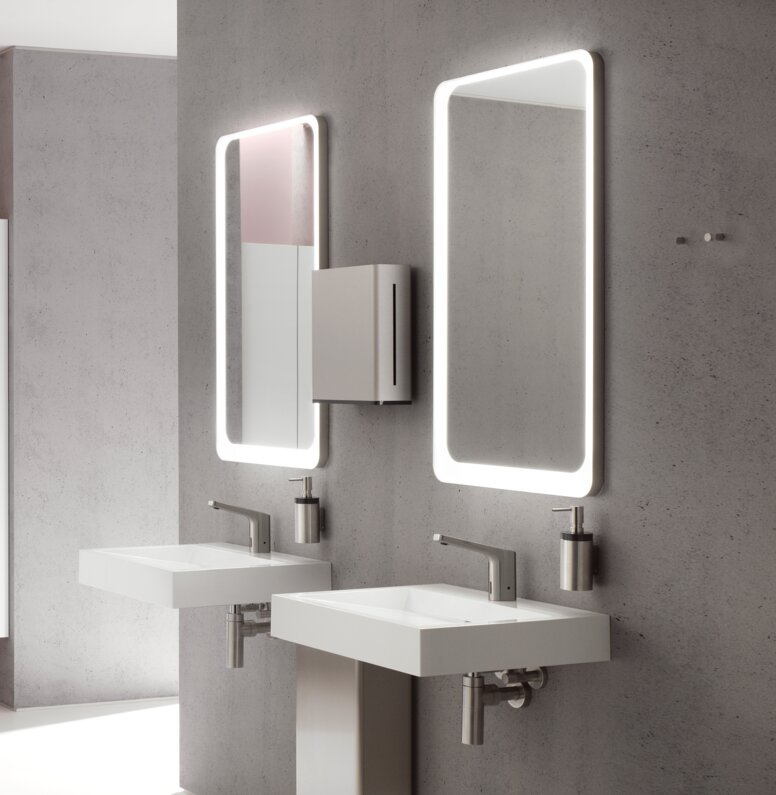
5. Plan suitable windows in the sustainable bathroom
If you plan for windows in a sustainable bathroom, this immediately offers several ecological advantages. For one thing, windows provide natural daylight, so your customers use less electricity than in a bathroom with no windows. In addition, windows in sustainable bathrooms contribute to heat build-up. This saves heating costs and energy. Another advantage of windows in the bathroom is that your customers can easily ventilate the space. Bringing fresh air in and letting damp air out prevents the formation of mould in bathrooms, which tend to have a more humid indoor climate, and keeps the bathroom looking beautiful for a long time.
6. Use energy-saving light in the sustainable bathroom
Light plays an essential role in the bathroom. Especially in the dark winter months and at night, it allows your customers to see where they’re going and enables comfortable use of the sanitary facilities. A long service life is therefore required of the light bulbs. Therefore, when planning, go for energy-saving variants. LED light bulbs noticeably reduce power consumption and thus contribute to environmental protection.
Glare-free LED mirrors are perfect for illuminating your customers’ faces and other areas of the sustainable bathroom. A high-quality LED mirror provides for even lighting. The LEDs are located behind a satinised mirror rim that reproduces the colours as they really are. The light of the mirror is warm white and creates a pleasant ambience in the bathroom.
Sustainable bathroom design: A wide variety of aspects are important
Be it with resource-saving or easy-care products, windows, energy-saving light, sustainable materials, forward-looking planning or environmentally conscious manufacturing – with a sustainably designed and well thought-out bathroom, you make a contribution to climate protection and promote the social integration of older or physically impaired people.
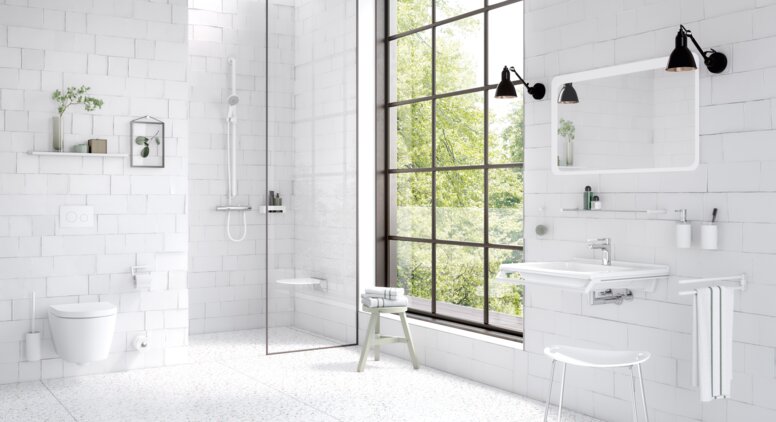
Stay informed
In our newsletter, we inform you about interesting topics and innovations from the areas of building hardware and sanitation. Always stay up to date and subscribe to the HEWI Newsletter.
